
Another year is upon us, and it seems an appropriate time to ask Our Members to share some of their recent acquisitions with all of us, and perhaps comment on trends in their interests and how those trends have evolved over time.
As certain areas of interest within our collections become filled (often, overfilled..), new foci for collecting eventually reveal themselves. For collectors who tend to stay in the lower price ranges, a large number of interesting pieces can be acquired before a trend emerges from the noise. For those fortunate enough to be able to contemplate a few four- or five-figure purchases, I rather imagine that such focus is typically developed before the checks are written. Or not, for the badly infected…
In the case of the author, piled Afghan, Turkoman, and NE Persian tribal goods, and Uzbek and Afghan embroidered goods, were of primary interest for almost two decades. We lived in the Middle East for a long time, but found that most of the good old pieces were long ago removed to Frankfurt, Boston, and London - not Teheran or Ashgabat. While there, we were able to find a few nice old Baluchi and Turkoman pieces, and two nice Persian tribal rugs, at prices we were willing to pay. Mid-20th century Afghan and Baluchi work was plentiful, some of which was very well done. Spousal preference for new city rugs led to the acquisition of some extremely fine Tabriz and Qom pieces.
Those markets were mostly filled with eerily brilliant (or worse, chem.-washed) recent Shirazi rugs, new refugee Afghan and Baluch production with ghastly shades of crimson, a weird yellow-green, pink, and dull brown (with one exception, we declined to participate), nice new vegetal-dyed gabbehs from Iran, and equally nice vegetal-dyed Caucasian knockoffs from Afghanistan. A few interesting mid-20th century south Persian rugs were around - we bought two - that had sufficient randomness and originality in the design to convince us that they were probably not production line junk.
Over the last 2-3 years increased interest in, and appreciation for, Persian and/or Caucasian flatweave bags has become a driver for buying behavior. That said, the author also tends to have an itchy trigger finger, diverse interests, and a boteh-loving spouse/critic to accommodate. As a result, Afshar pile bags have emerged as a secondary, partly intentional, trend. Small pieces have dominated over large, as has been the habit for several years now, following Dr. Weiler’s prescription for maintaining a balance between closet space and residual spending capacity. We still buy fewer, interesting rugs, but no more large carpets.
Market availability has also had a significant impact on recent purchases. Now that we’re back in the west, a much broader selection of interesting Persian, Caucasian, and older Baluch and Central Asian pieces is now within reach (additional credit to the internet). Some of them have now been removed from the market and are available for viewing below. It should be noted that finding the rarest of pieces is an aspiration of mine, but aspirations don’t fill a need, so affordable pieces that hold personal interest are what we’ll see here – some detail of the construction, colors and/or design elements attractive to the eye, a filled provenance niche - are all elements of a purchase. These were acquired over the past couple few years.
We’ll start with a review of the flatweave pieces, go on to take a look at some Afshar bags, and then toss a bone to the Turkomaniacs among us.
Part 1: Flatweave Bags
The first example from the flatweave focal area is this half-khorjin, represented by the seller as Shahsevan. Maybe. In literature, I have seen similar work attributed to Shahsevan, Qashqai, and Veramin sources. So, I’m curious to see what the members have to say about this one.
The front…:
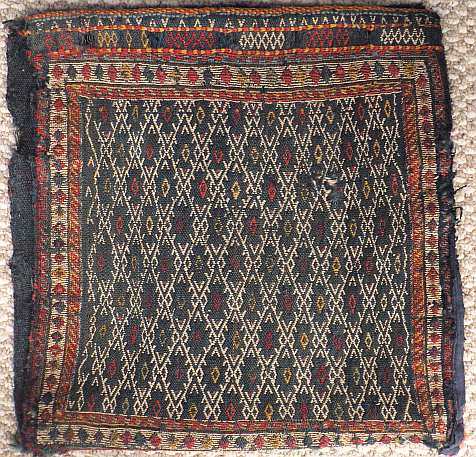
…and the back:

One interesting characteristic of this piece is that, from a moderate distance, the ground fabric actually appears to take on greenish cast to the overall dark blue. Upon close examination, one observes that much of the weft material is deep crimson-red. Oddly, it is this feature that produces the effect. Standard color theory predicts that the piece, with blue warps, would have an overall purple cast as a result, but such is not the case.
Weft yarn exposure is variable, but significant in this area:

The white details are worked with very fine handspun cotton. Other colors are hard to judge (for me), but it is noted that there is no evidence of color run in a piece that appears to have worked for a living.
This piece, in detail, reveals a most tedious construction technique. On the whole, that is probably a fair statement for most complex flatweaves (soumak in particular, as some of this work appears to be). In this case, I am noting the effort required to maintain constant spacing between the fine white highlight lines in the borders:
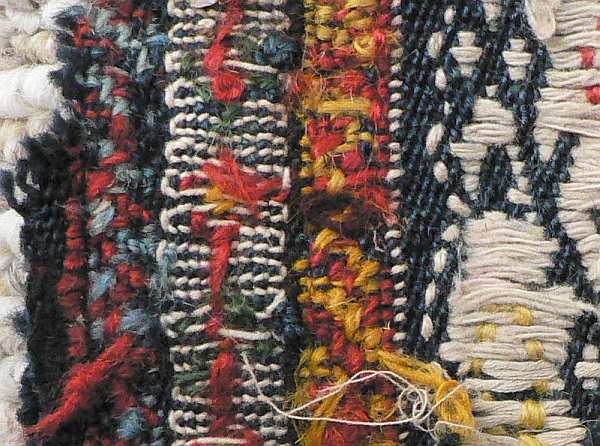
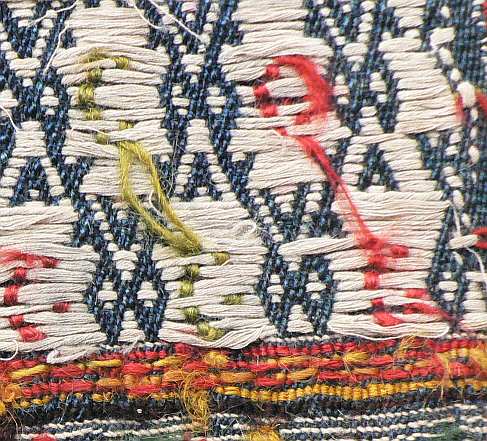
The next piece we’ll look at was represented as having Qashqai origin. I don’t have much familiarity with Qashqai flatweave work, but this piece fits what little I (may) know of it – use of the slitweave technique (on the back), typical design elements, checkerboard borders, descending yarn ropes, etc.
The front…:
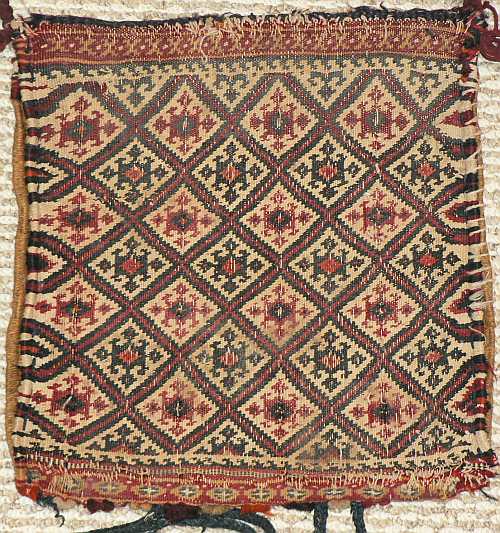
…the back:
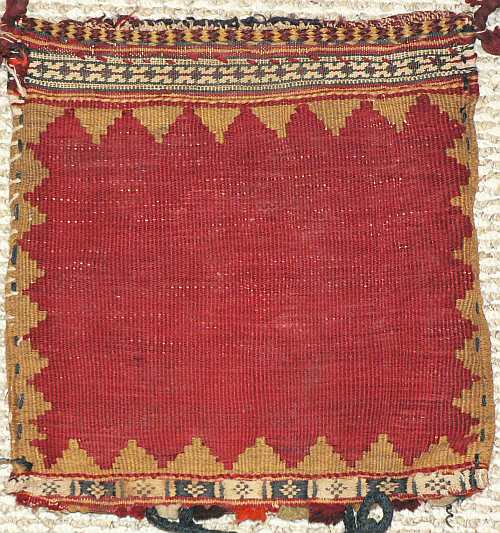
This piece is an example of extremely fine weaving at 20 warps x 20 wefts per square inch:
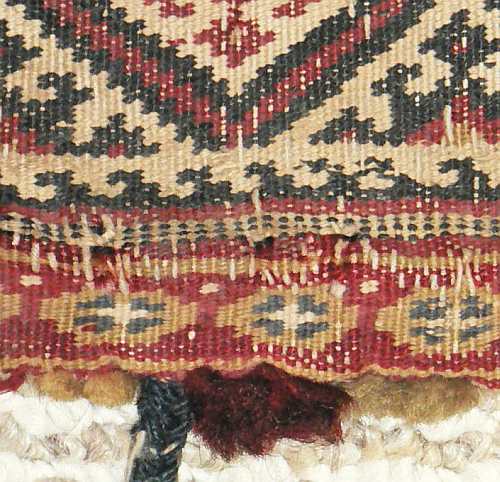
Here are some close-ups of the edge and checkerboard (exposed floating weft) treatments.

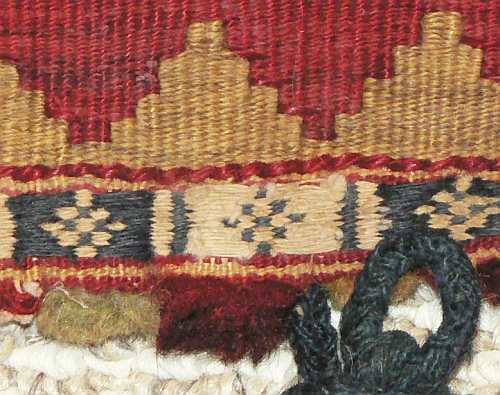
The selvage is made of continuous wefts wrapped around several cords of bundled warp yarn:
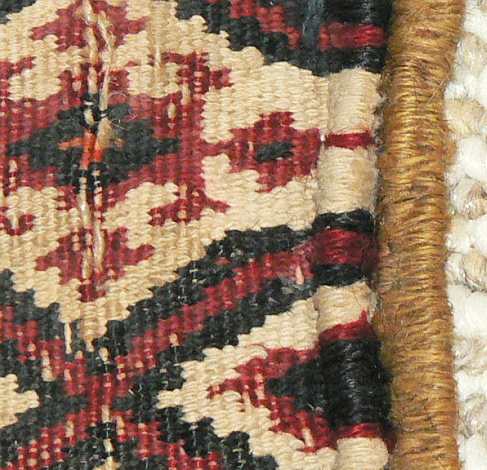
This next piece is mixed flatweave-pile Bakhtiari-Lor khorjin, most likely from the Veramin region, intact and inscribed with a date of 1311 Hijra, which is 1893 or 1933 Gregorian, depending on which Persian calendar is used. Jenny Housego and John Wertime show bags with similar designs in their books, noting that this is probably a representation of the Dragon/Phoenix legend.
Hey Sophia! Dragons! Finally!
Several weaving styles are combined with deep, rich colors to make a very attractive piece. The dark blues, greens, and purple of the field and detail work are best appreciated in bright light. Also, a note: certain elements of this bag have previously appeared in some previous Show & Tell posts.
The front…
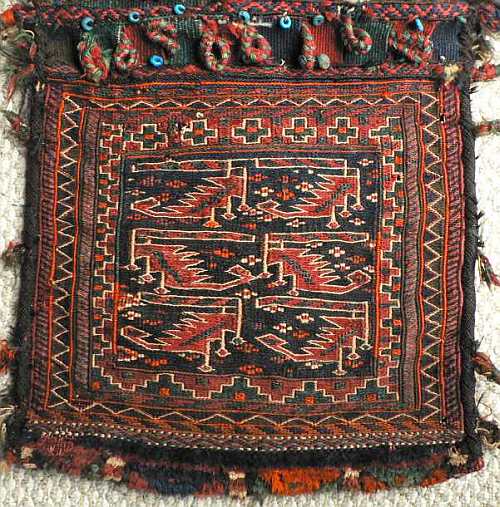 :
:
…the back (no, the orange hasn’t run – see next image):
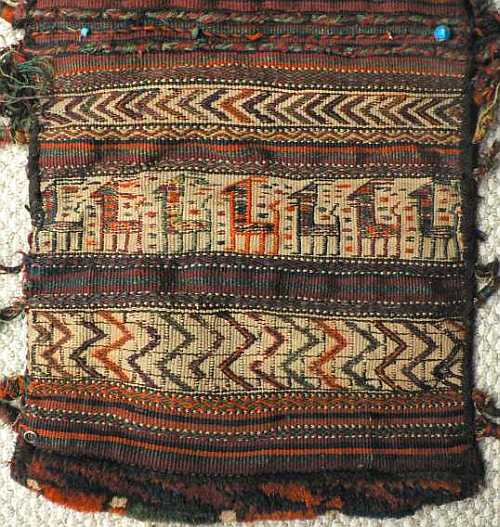
a closeup of the critters:
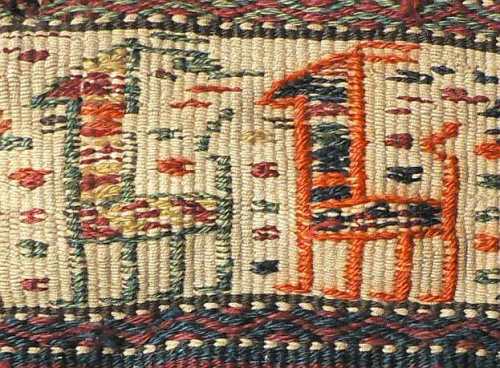
…a deep palette:
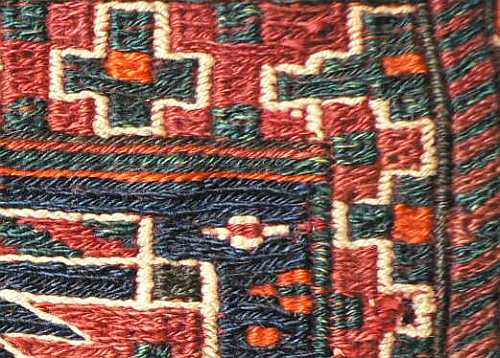
…the date inscription:
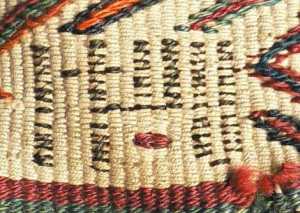
…edge treatment
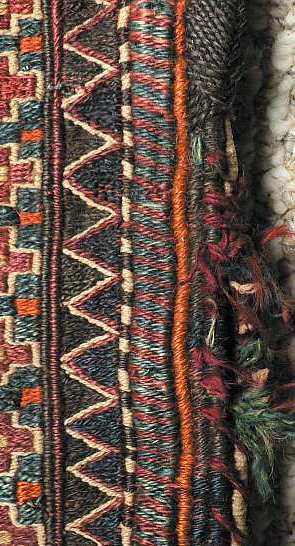
Rounding out the flatweave focus section, here are two pieces which have been the subject of Show & Tell sessions in the past. As a result, I’ll refrain from adding much commentary:
The first is another mixed flatweave-pile Bakhtiari-Lor piece with an undyed ivory wool ground, described as a spindle bag:

…pile detail:
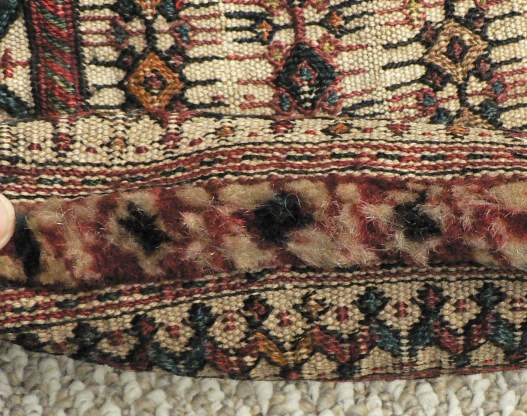
and a palette with some similarities to the khorjin above:
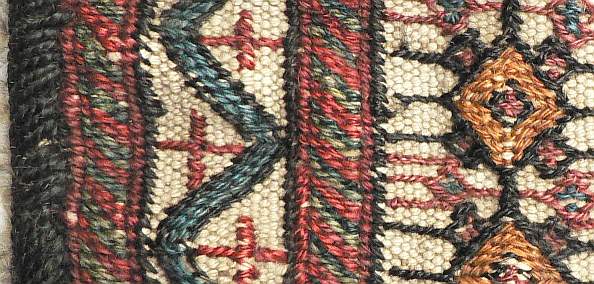
Finally, a Shahsevan khorjin with a pleasant palette and a classic design:
The front…:
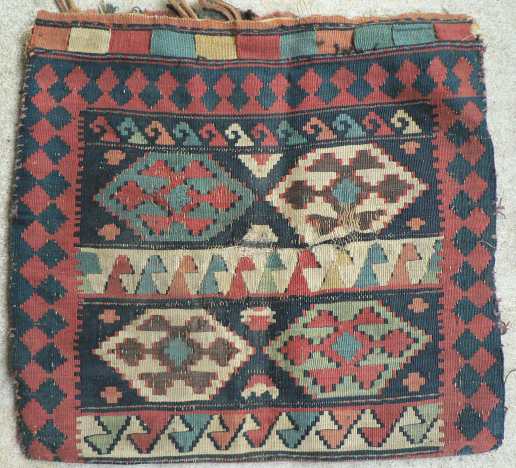
…the back:
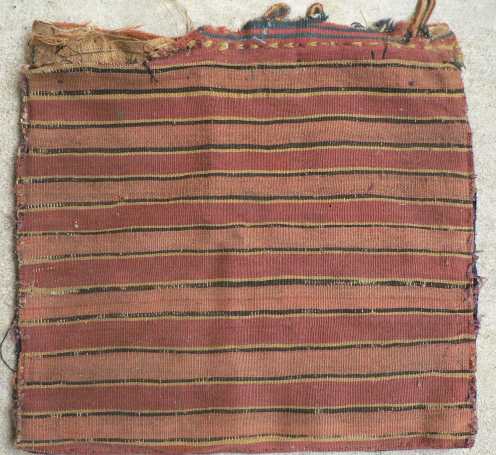
…some detail:
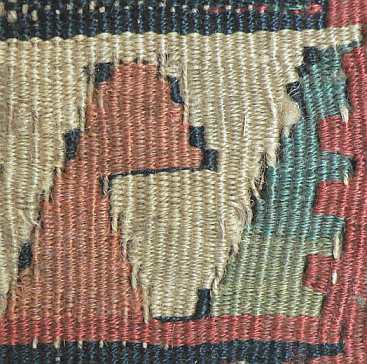
Part 2: Afshar Bags
My spousal unit has a genuine fondness for the boteh design, and some of the nicest boteh treatments appear in Afshar weavings. So, tattered as it may be, this first piece joined our collection. It’s a classic Afshar bagface, with pleasant dyes and enough character to let us ignore the odd bits of low pile and missing edges. This was the first side of the bag to be completed, which was woven from top of this face (the pile points upward). The weaver clearly had issues with border corner resolution, but handled the interior layout with aplomb.

Note symmetrical knots pointing upward:
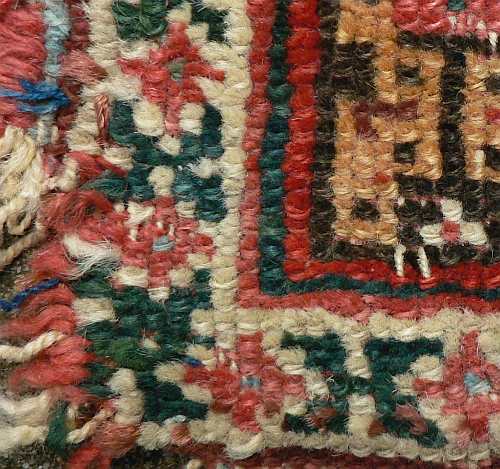
Two views of the back:
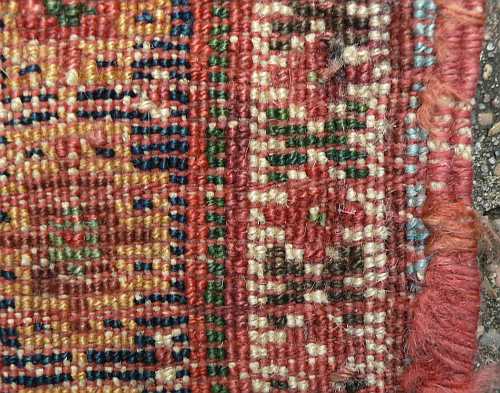
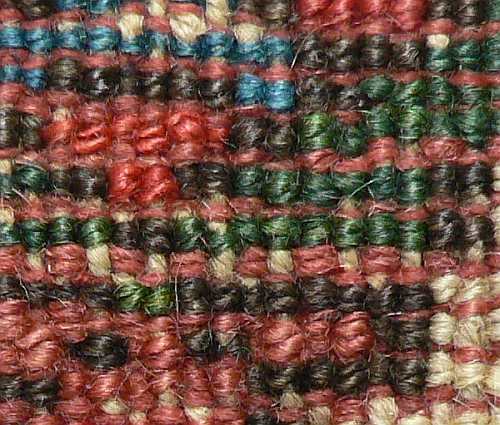
Continuing with the floral theme, here is another battleworn bagface with a well known Afshar motif. Lower budgets mean you only get part of the bag. Still, the colors are vibrant and that part of the bag that is not in awful shape - is in great shape. The field is undyed ivory wool, not bright white, and loaded with lots of little smilie-like totemic filler designs.
The front…:
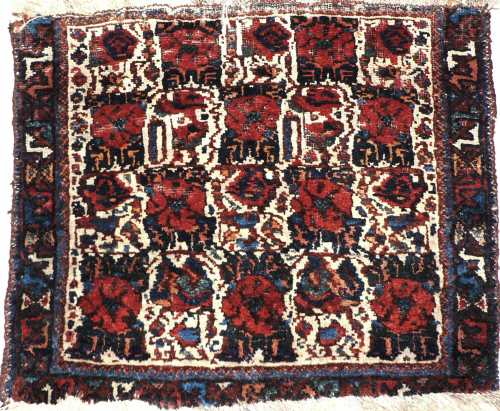
…the back:
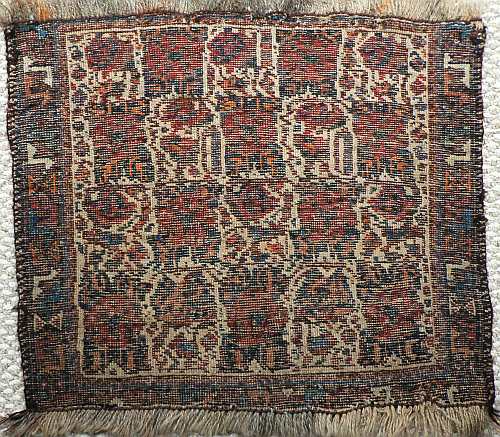
…a closeup of the knots; note the undyed ivory warps rather than pink or red…:
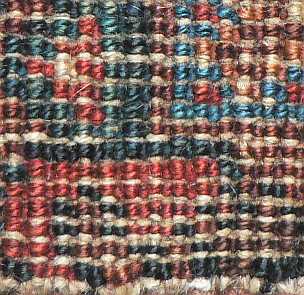
…and an example of the pile condition, showing the symmetrical knots:
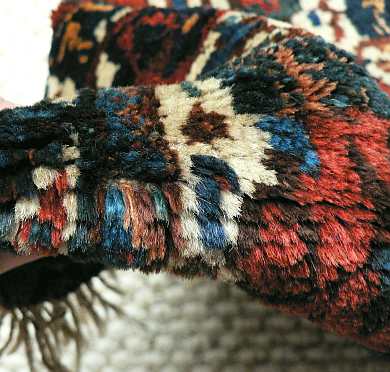
Last of the Afshar bags is this unusual piece (I think). At 34 x 23 ½ inches, it is larger and wider than most khorjins, midway between a khorjin and a chuval, but too small to be part of a mafrash. I’m no Afshar expert, but the design looks like a combination of Afshar borders and Qashqai medallions. I’ll be interested in hearing any comments. This piece is in great condition, and was also woven starting at the top of this face.
The face…
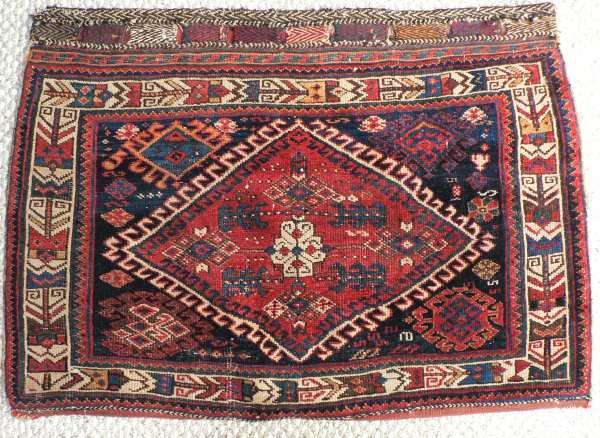
…the back…:
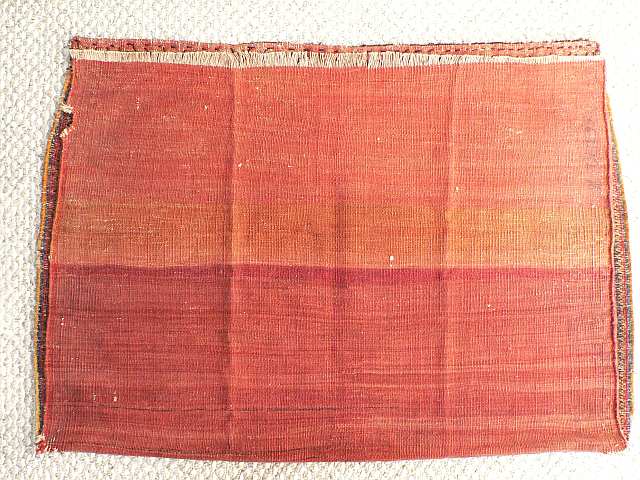
…the knots. And, again, light brown, rather than pink or red, wefts:

There is some nice abrash as well…:
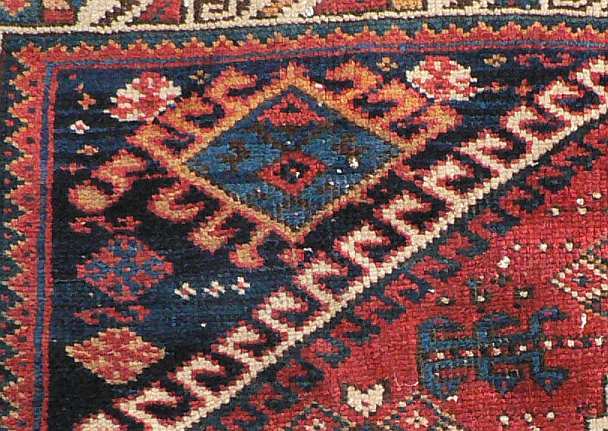
…and classic end and closure treatment:
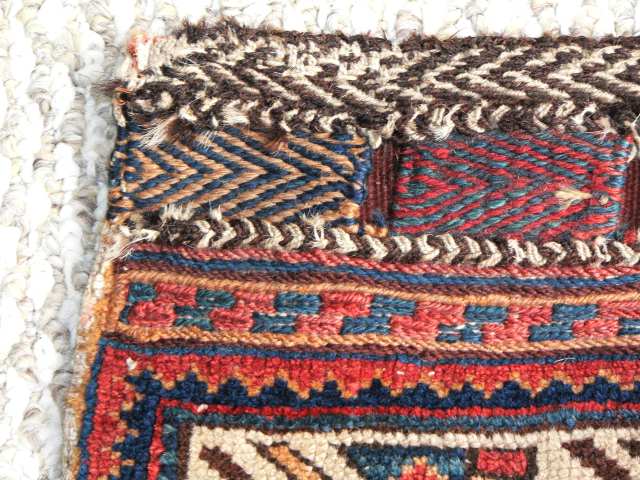
Part 3: The Turkomaniac Finale
In keeping with the constant pursuit of not-found-that-often Turkoman pieces and the flatweave theme, this little chanteh found its way into our collection as well. It may not really be that unusual, but I haven’t seen many of these myself:
Front…
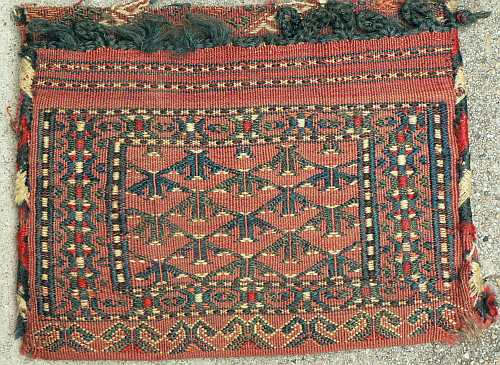
…back:

..in detail, nice colors:
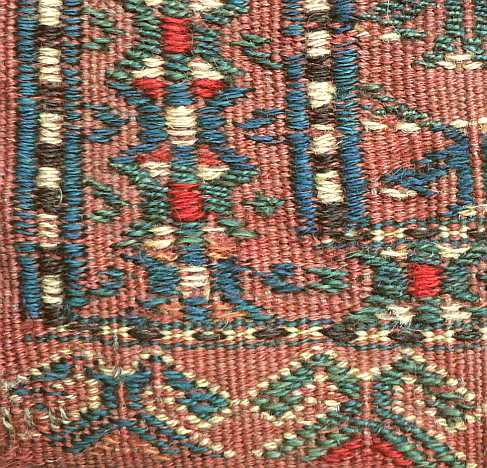
…and finally, the closure system:
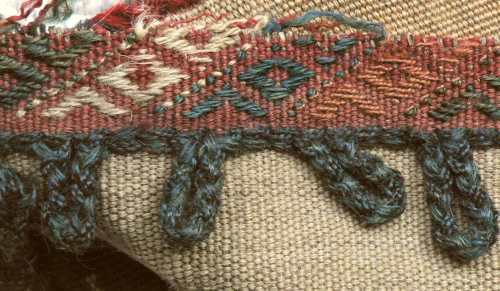
OK, folks, that’s it. There’s my contribution to the “what have you been up to lately, and why” discussion. Please take some time and share with us. If you have questions or comments about the pieces above, I’ll be happy to answer and/or post a few more images.
Regards,
Chuck Wagner